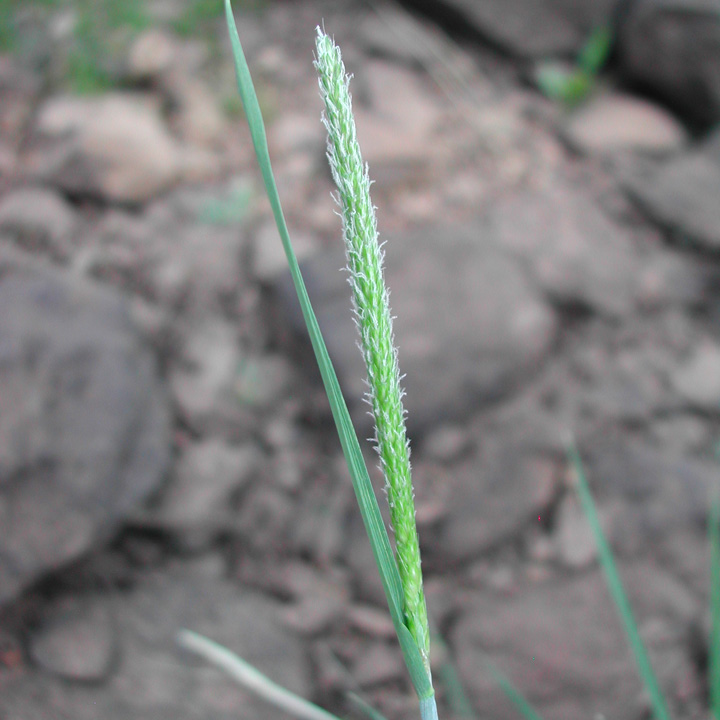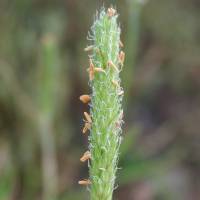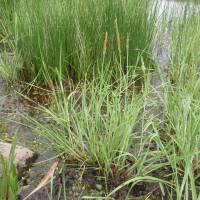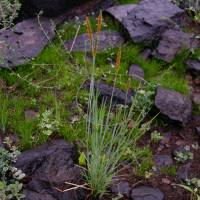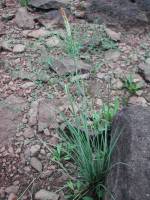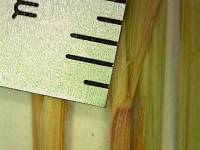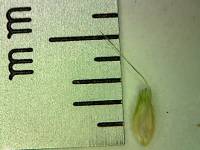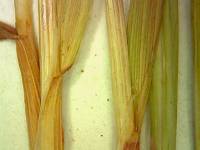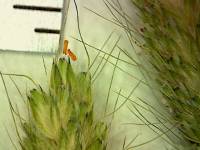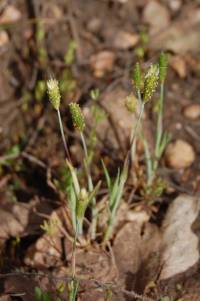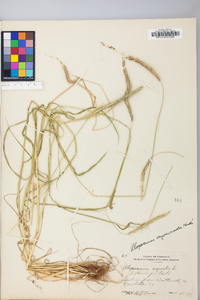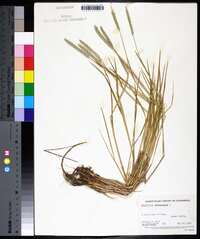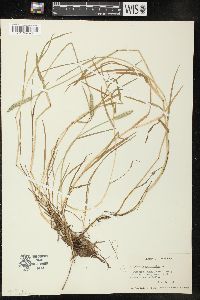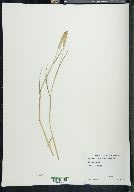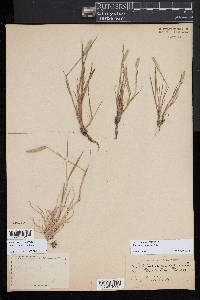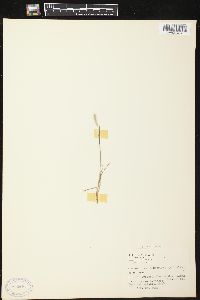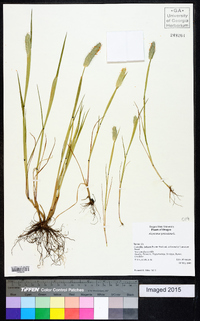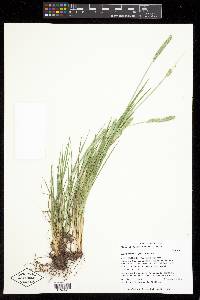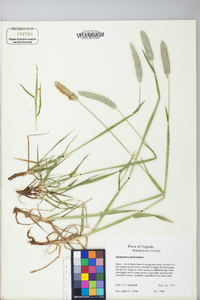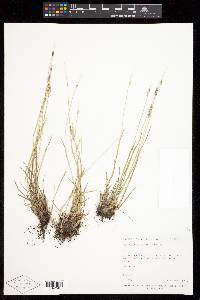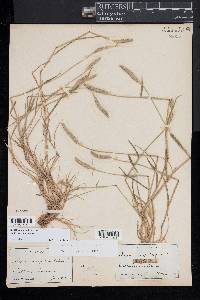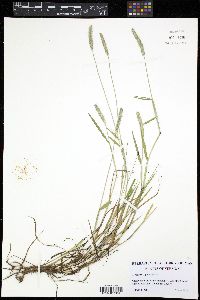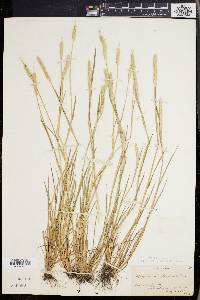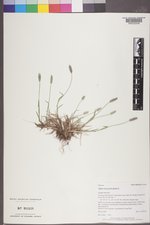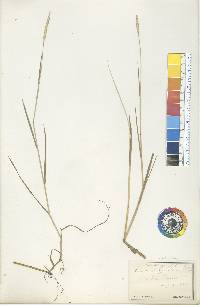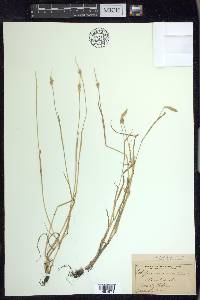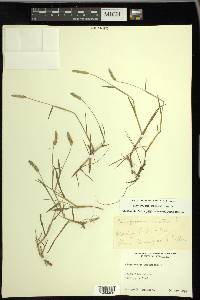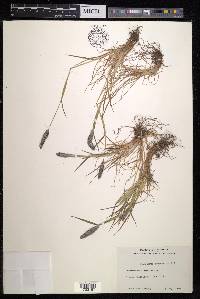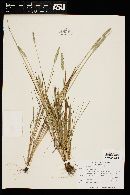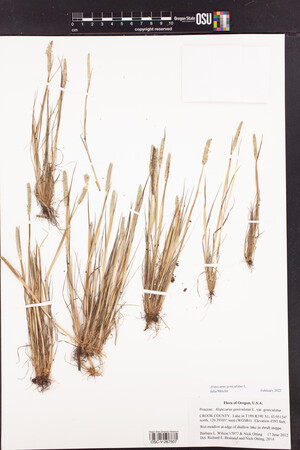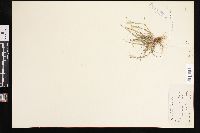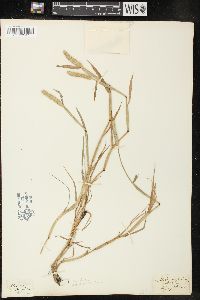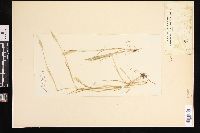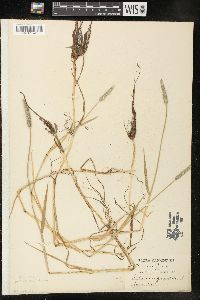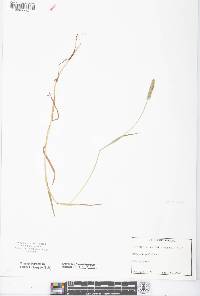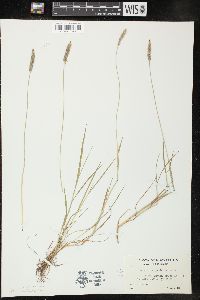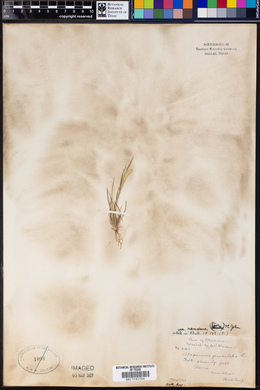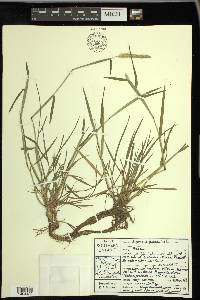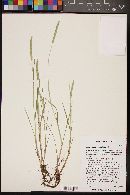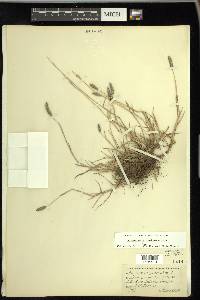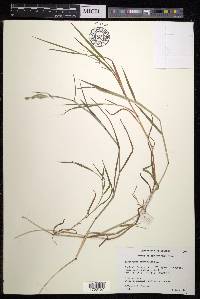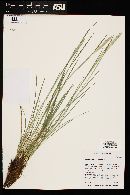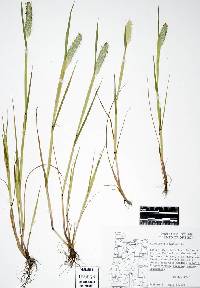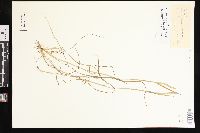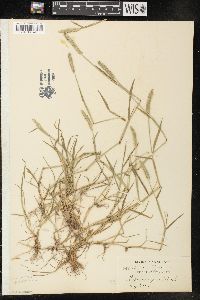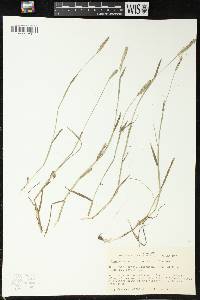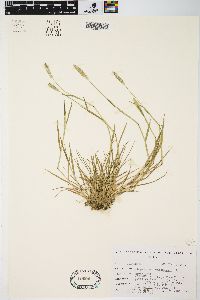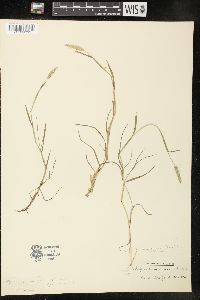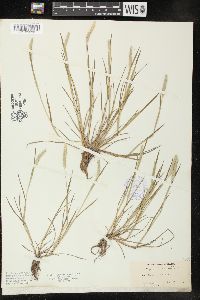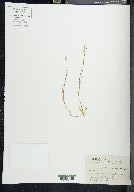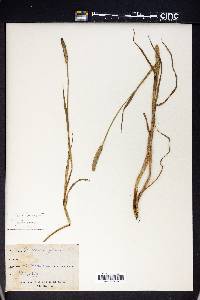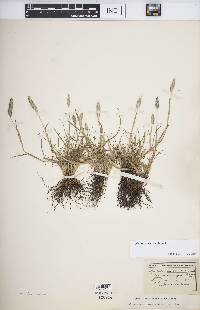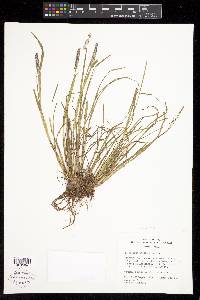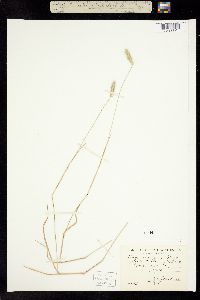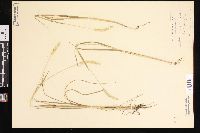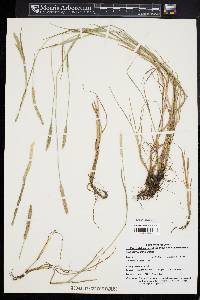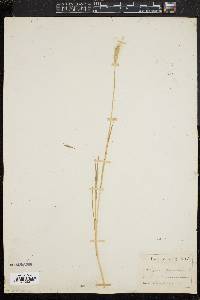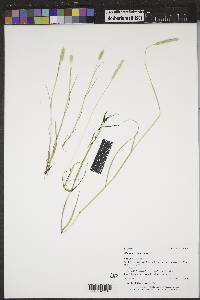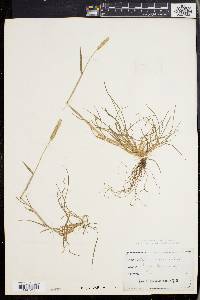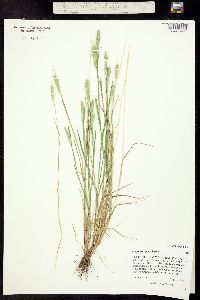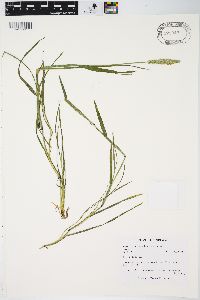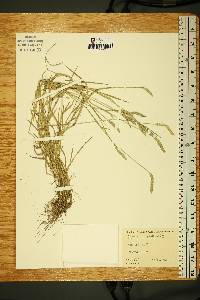
|
|
|
|
Family: Poaceae
Marsh Meadow-Foxtail, more...water foxtail, Vulpin Géniculé
[Alopecurus australis Nees, moreAlopecurus geniculatus var. aquaticus Schltdl., Alopecurus geniculatus var. microstachyus Uechtr., Alopecurus pallescens Piper, Alopecurus palustris subsp. geniculatus (L.) Syme ex Sowerby] |
Plants perennial; cespitose. Culms (5)10-60 cm, erect or decumbent, rooting at the nodes. Ligules 2-5 mm, obtuse; blades 2-12 cm long, 1-4(7) mm wide; upper sheaths somewhat inflated. Panicles 1.5-7 cm long, 4-8 mm wide. Glumes 1.9-3.5 mm, connate atthe base, membranous, pubescent, keels not winged, ciliate, apices obtuse, parallel, often purplish; lemmas 2.5-3 mm, connate in the lower 1/2, glabrous or with a few scattered hairs at the apices, apices truncate to obtuse, awns 3.5-5(6) mm, geniculate, exceeding the lemmas by (1.2)2-4 mm; anthers (0.9)1.4-2.2 mm, yellow. Caryopses 1-1.5 mm. 2n = 28. Alopecurus geniculatus is native to Eurasia and parts of North America, growing in shallow water, ditches, open wet meadows, shores, and stream banks from the lowland to montane zones. It has been naturalized in eastern North America. The status of populations in the west, including the Queen Charlotte Islands, British Columbia, is less certain. Many occur in moist sites within native rangeland, but these areas have also been affected by European settlement, although less intensively and for a shorter period than those in eastern North America. Alopecurus haussknechtianus Asch. & Graebn. is a hybrid between A. geniculatus and A. aequalis, which occurs fairly frequently in areas of sympatry, particularly in drier midcontinental areas in Alberta to Saskatchewan, south to Arizona and New Mexico. The hybrids appear to have 2n = 14; they are sterile. Dr. David Bogler, USDA NRCS PLANTS Database Perennials, Terrestrial, not aquatic, Stems nodes swollen or brittle, Stems erect or ascending, Stems geniculate, decumbent, or lax, sometimes rooting at nodes, Stems caespitose, tufted, or clustered, Stems terete, round in cross section, or polygonal, Stem internodes hollow, Stems with inflorescence less than 1 m tall, Stems, culms, or scapes exceeding basal leaves, Leaves mostly cauline, Leaves conspicuously 2-ranked, distichous, Leaves sheathing at base, Leaf sheath m ostly open, or loose, Leaf sheath smooth, glabrous, Leaf sheath and blade differentiated, Leaf blades linear, Leaf blades 2-10 mm wide, Leaf blades mostly flat, Leaf blades mostly glabrous, Ligule present, Ligule an unfringed eciliate membrane, Inflorescence terminal, Inflorescence a dense slender spike-like panicle or raceme, branches contracted, Inflorescence solitary, with 1 spike, fascicle, glomerule, head, or cluster per stem or culm, Inflorescence spike linear or cylindric, several times longer than wide, Inflorescence single raceme, fascicle or spike, Flowers bisexual, Spikelets pedicellate, Spikelets laterally compressed, Spikelet less than 3 mm wide, Spikelets with 1 fertile floret, Spikelets solitary at rachis nodes, Spikelets all alike and fertille, Spikelets bisexual, Spikelets disarticulating below the glumes, Rachilla or pedicel glabrous, Glumes present, empty bracts, Glumes 2 clearly present, Glumes equal or subequal, Glumes equal to or longer than adjacent lemma, Glume margins connate at base, Glumes keeled or winged, Glumes 3 nerved, Lemmas thin, chartaceous, hyaline, cartilaginous, or membranous, Lemma margins connate below, Lemma 5-7 nerved, Lemma glabrous, Lemma body or surface hairy, Lemma apex truncate, rounded, or obtuse, Lemma distinctly awned, more than 2-3 mm, Lemma with 1 awn, Lemma awn less than 1 cm long, Lemma awn 1-2 cm long, Lemma awn subapical or dorsal, Lemma awn once geniculate, bent once, Lemma margins thin, lying flat, Lemma straight, Stamens 3, Styles 1, Styles 2-fid, deeply 2-branched, Stigmas 2, Fruit - caryopsis, Caryopsis ellipsoid, longitudinally grooved, hilum long-linear.
FNA 2007, Field Guide to Forest & Mtn Plants of N AZ 2009, Ann. Checklist GCNP 1987 Common Name: water foxtail Duration: Perennial Nativity: Non-native Lifeform: Graminoid General: Introduced perennial bunchgrass with stems to 60 cm tall, erect or decumbent, with an inflorescence of dense panicles to 7 cm long. Vegetative: Cespitose, stems erect, bent and decumbent, stems 10-60 cm, rooting at the lower nodes, ligules 2-5 mm long, acut to obtuse, leaf blades flat, 2-12 cm long, 1-4 mm wide, sheaths open, upper sheaths slightly inflated. Inflorescence: Dense cylindrical panicles 1-7 cm long, 4-8 mm wide, spikelets flattened and overlapping, 2-3 mm long, glumes fused at the base, 2-3 mm long, membranous and pubescent, with unwinged keels and obtuse apices, often purplish; lemmas 2-3 mm long, glabrous, apices truncate to obtuse, awns 3-5 mm long emerging near the middle of the lemma, anthers 1-2 mm long. Ecology: Found in wet areas such as wet meadows, pools, seeps, moist canyons, and streambanks at 600-2700 m (2000-9000 ft) from a lowland to mountain regions. Flowers July-September. Sometimes forms roots near the base of the plant. Distribution: Found in most western and northern states. Ethnobotany: Unknown Etymology: Alopecurus comes from the Greek alopekouros, meaning a grass like a fox's tail, while geniculatus means jointed or bent at a node. Editor: Lkearsley2012 Perennial; culms 2-8 dm, usually decumbent, sometimes rooting at the nodes; infl 3-5 cm נ4-6 mm, often purple-tinged; glumes as in no. 5 [Alopecurus carolinianus Walter]; awn attached halfway between the base and the middle of the lemma, geniculate, exserted 1.5-3.5 mm; anthers 1.3-2 mm; 2n=28. In mud and shallow water; a Eurasian or perhaps circumboreal sp., found throughout most of our range as an apparent introduction. Gleason, Henry A. & Cronquist, Arthur J. 1991. Manual of vascular plants of northeastern United States and adjacent Canada. lxxv + 910 pp. ©The New York Botanical Garden. All rights reserved. Used by permission. |
|
|
|

